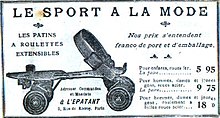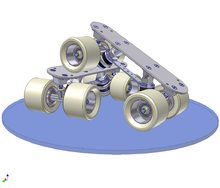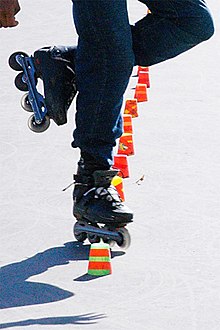History
- 1743: First recorded use of roller skates, in a London stage performance. The inventor of this skate is unknown.
- 1760: First recorded skate invention, by John Joseph Merlin, who created a primitive inline skate with small metal wheels.
- 1818: Roller skates appeared on the ballet stage in Berlin.
- 1819: First patented roller skate design, in France by M. Petitbled. These early skates were similar to today's inline skates, but they were not very maneuverable. It was difficult with these skates to do anything but move in a straight line and perhaps make wide sweeping turns.
- Rest of the 19th century: inventors continued to work on improving skate design.
- 1823: Robert John Tyers of London patented a skate called the Rolito. This skate had five wheels in a single row on the bottom of a shoe or boot.
- 1857: Finally, roller skating had gained enough momentum to warrant the opening of the first public skating rinks. The Strand, London and Floral Hall had these first roller rinks.
- 1863: The four-wheeled turning roller skate, or quad skate, with four wheels set in two side-by-side pairs (front and rear), was first designed, in New York City by James Leonard Plimpton in an attempt to improve upon previous designs. The skate contained a pivoting action using a rubber cushion that allowed the skater to skate a curve just by pressing his weight to one side or the other, most commonly by leaning to one side. It was a huge success, so much so that the first public roller skating rinks were opened in 1866, first in New York City by Plimpton in his furniture store and then in Newport, Rhode Island with the support of Plimpton. The design of the quad skate allowed easier turns and maneuverability, and the quad skate came to dominate the industry for more than a century.
- 1875 Roller skating rink in Plymouth, England held its first competition.
- 1876: William Brown in Birmingham, England, patented a design for the wheels of roller skates. Brown's design embodied his effort to keep the two bearing surfaces of an axle, fixed and moving, apart. Brown worked closely with Joseph Henry Hughes, who drew up the patent for a ball or roller bearing race for bicycle and carriage wheels in 1877. Hughes' patent included all the elements of an adjustable system. These two men are thus responsible for modern roller skate and skateboard wheels, as well as the ball bearing race inclusion in velocipedes—later to become motorbikes and automobiles. This was arguably the most important advance in the realistic use of roller skates as a pleasurable pastime.
- 1876: The toe stop was first patented. This provided skaters with the ability to stop promptly upon tipping the skate onto the toe. Toe stops are still used today on most quad skates and on some types of inline skates.
- 1877: The Royal Skating indoor skating ring building is erected rue Veydt, Brussels.
- 1880s: Roller skates were being mass-produced in America from then. This was the sport's first of several boom periods. Micajah C. Henley of Richmond, Indiana produced thousands of skates every week during peak sales. Henley skates were the first skate with adjustable tension via a screw, the ancestor of the kingbolt mechanism on modern quad skates.
- 1884: Levant M. Richardson received a patent for the use of steel ball bearings in skate wheels to reduce friction, allowing skaters to increase speed with minimum effort.
- 1898: Richardson started the Richardson Ball Bearing and Skate Company, which provided skates to most professional skate racers of the time, including Harley Davidson (no relation to the Harley-Davidson motorcycle brand). (Turner and Zaidman, 1997).
-
- The design of the quad skate has remained essentially unchanged since then, and remained as the dominant roller skate design until nearly the end of the 20th century. The quad skate has begun to make a comeback recently due to the popularity of roller derby and jam skating.
- 1900: The Peck & Snyder Company patented an inline skate with two wheels.
- 1902: The Chicago Coliseum opened a public skating rink. Over 7,000 people attended the opening night.
- 1977: Inline skates looking like ice skates were used by the makers of the east German DEFA movie "Die zertanzten Schuhe" based on the fairy tale The Twelve Dancing Princesses in some winter scenes on a frozen lake.
- 1979: Scott Olson and Brennan Olson of Minneapolis, Minnesota came across a pair of inline skates created in the 1960s by the Chicago Roller Skate Company and, seeing the potential for off-ice hockey training, set about redesigning the skates using modern materials and attaching ice hockey boots. A few years later Scott Olson began heavily promoting the skates and launched the company Rollerblade, Inc..
- 1993 - Active Brake Technology, Rollerblade, Inc. developed ABT or Active Brake Technology for increased safety.
During the late 1980s and early 1990s, the Rollerblade-branded skates became so successful that they inspired many other companies to create similar inline skates, and the inline design became more popular than the traditional quads. The Rollerblade skates became synonymous in the minds of many with "inline skates" and skating, so much so that many people came to call any form of skating "Rollerblading," thus making it a genericized trademark.
For much of the 1980s and into the 1990s, inline skate models typically sold for general public use employed a hard plastic boot, similar to ski boots. In or about 1995, "soft boot" designs were introduced to the market, primarily by the sporting goods firm K2 Inc., and promoted for use as fitness skates. Other companies quickly followed, and by the early 2000s the development of hard shell skates and skeletons became primarily limited to the Aggressive inline skating discipline and other specialized designs.
The single-wheel "quintessence skate" was made in 1988 by Miyshael F. Gailson of Caples Lake Resort, California, for the purpose of cross-country skate skiing and telemark skiing training. Other experimental skate designs the years have included two wheeled (heel and toe) inline skate frames but the vast majority of skates on the market today are either quad or standard inline design.
Artistic roller skating
Artistic roller skating is a sport which consists of a number of events. These are usually accomplished on quad skates, but inline skates may be used for some events. Various flights of events are organized by age and ability/experience. In the US, local competitions lead to 9 regional competitions which led to the National Championships and World Championships.
Figures
A prescribed movement symmetrically composed of at least two circles, but not more than three circles, involving primary, or primary and secondary movements, with or without turns. Figures are skated on circles, which have been inscribed on the skating surface.
Dance
In competition skaters can enter more than one event;
Solo Dance; solo dance a competition starts at tiny tot and goes up to golden, for a test it starts with bronze and goes up to gold. You do not have to take tests anymore to skate in harder categories, you must have a couple of tests once you get to a certain event, though. In competition, these dances are set patterns and the judges give you marks for good edges, how neat they look and how well they do turns, etc.
Team Dance; this is where two people skate together doing the set dances. Most people skate with a partner the same ability and age.
Skaters are judged by the accuracy of steps that they skate when performing a particular dance. In addition to being judged on their edges and turns, skaters must carry themselves in an elegant manner while paying careful attention to the rhythm and timing of the music.
Freestyle
Freestyle roller dancing is a style of physical movement, usually done to music, that isn’t choreographed or planned ahead of time. It occurs in many genres, including those where people dance with partners. By definition, this kind of dance is never the same from performance to performance, although it can be done formally and informally, sometimes using some sparse choreography as a very loose outline for the improvisation.
Precision teams
A team of skaters (usually counted in multiples of 4) creates various patterns and movements to music. Often used elements include skating in a line, skating in a box, 'splicing' (subgroups skating towards each other such that they do not contact each other), and skating in a circle. The team is judged on its choreography and the ability to skate together precisely.
Singles and pairs
A single skater or a pair of skaters present routines to music. They are judged on skating ability and creativity. Jumps, spins and turns are expected in these events. Sometimes with a pair or couple skaters slow music will play, and usually it is two songs.
Speed skating
Speed skating originally started on traditional roller skates. The speed skating season began in fall and continued through spring leading up to a state tournament. Placing in the top three places at a state tournament would qualify skaters for a regional tournament. The top three places at regional tournaments then went on to compete at a national tournament. Skaters could qualify as individuals or as part of a two-person or four-person (relay) team. Qualification at regional events could warrant an invite to the Olympic Training Center in Colorado Springs, CO for a one-week training session on their outdoor velodrome. Inline speed skating is a competitive non-contact sport played on inline skates. Variants include indoor, track and road racing, with many different grades of skaters, so the whole family can compete.
Group skating
Among skaters not committed to a particular discipline, a popular social activity is the group skate or street skate, in which large groups of skaters regularly meet to skate together, usually on city streets. One such group is the San Francisco Midnight Rollers. In 1989 the small 15-20 group that became the Midnight Rollers explored the closed doubIedecker Embarcadero Freeway after the Loma-Prieta earthquake until it was torn down. At which point the new route was created settling on Friday nights at 9 pm from the San Francisco Ferry Building circling 12 miles around the city back at midnight to the start. Although such touring existed among quad roller skate clubs in the 1970s and 1980s, it made the jump to inline skates in 1990 with groups in large cities throughout the United States. In some cases, hundreds of skaters would regularly participate, resembling a rolling party. In the late 1990s, the group skate phenomenon spread to Europe and east Asia. The weekly Friday night skate in Paris, France (called Pari Roller) is believed to be one of the largest repeating group skates in the world. At times, it has had as many as 35,000 skaters participating on the boulevards of Paris, on a single night. The Sunday Skate Night in Berlin also attracts over 10,000 skaters during the summer, and Copenhagen, Munich, Frankfurt, Amsterdam, Buenos Aires, London, San Francisco, Los Angeles, New York, and Tokyo host other popular events. Charity skates in Paris have attracted 50,000 participants (the yearly Paris-Versailles skate). The current Official Guinness World Record holder is Nightskating Warszawa (Poland) in number of 4013 participants from 19 June 2014, but their real record from 25 April 2015 is 7303 participants and over 38 000 skaters total in 10 events in season 2015.
Aggressive inline
Aggressive inline skating is trick-based skating. This is where the individual performs tricks using a slightly different skate to normal. The skate has a grind block in between two wheels and the various companies have designed the boots to take these extra strains. Also the wheels have a flat large contact surface for grip.
Aggressive inline can either take place at a skate park or on the street. Typically predominantly grinds but also air tricks such as spins and flips.
Roller hockey (quad)
Roller hockey is the overarching name for a rollersport that existed long before inline skates were invented. Roller hockey has been played on quad skates in many countries worldwide and so has many names. Roller hockey at the 1992 Summer Olympics was a demonstration rollersport in the 1992 Summer Olympics in Barcelona.
Skating federations
In the United States, the controlling organization is USA Roller Sports, headquartered in Lincoln, Nebraska, also home of the National Museum of Roller Skating. Nationals are held each summer with skaters required to qualify through state and regional competitions.
Roller derby
Roller derby is a team sport played on roller skates on an oval track. Originally a trademarked product developed out of speed skating demonstrations, the sport is currently experiencing a revival as a grassroots-driven 5-a-side sport played mainly by women. Most roller derby leagues adopt the rules and guidelines set by the Women's Flat Track Derby Association or its male counterpart, Men's Roller Derby Association, but there are leagues that play on a banked track, as the sport was originally from c.1933-1998.







No comments:
Post a Comment